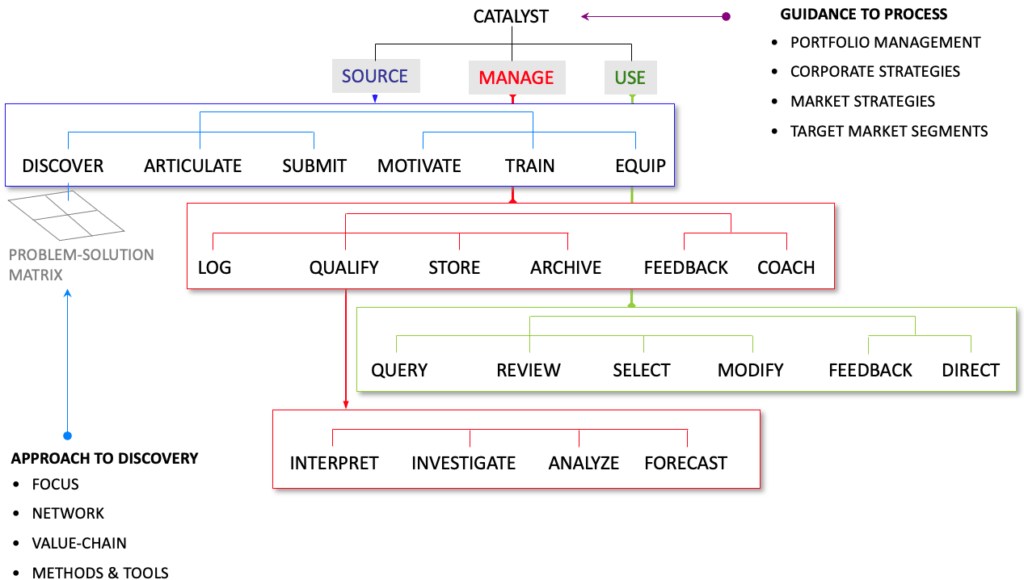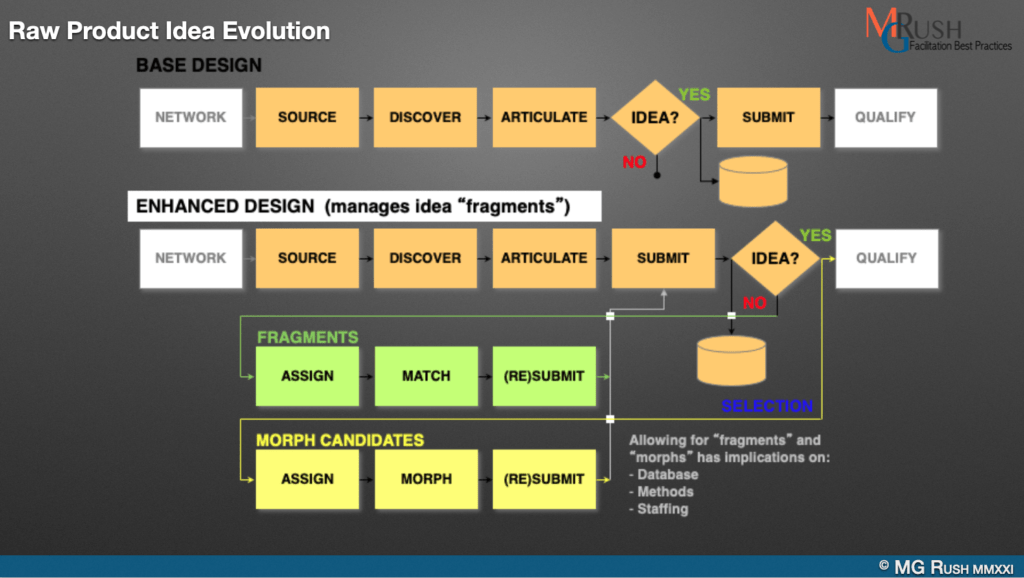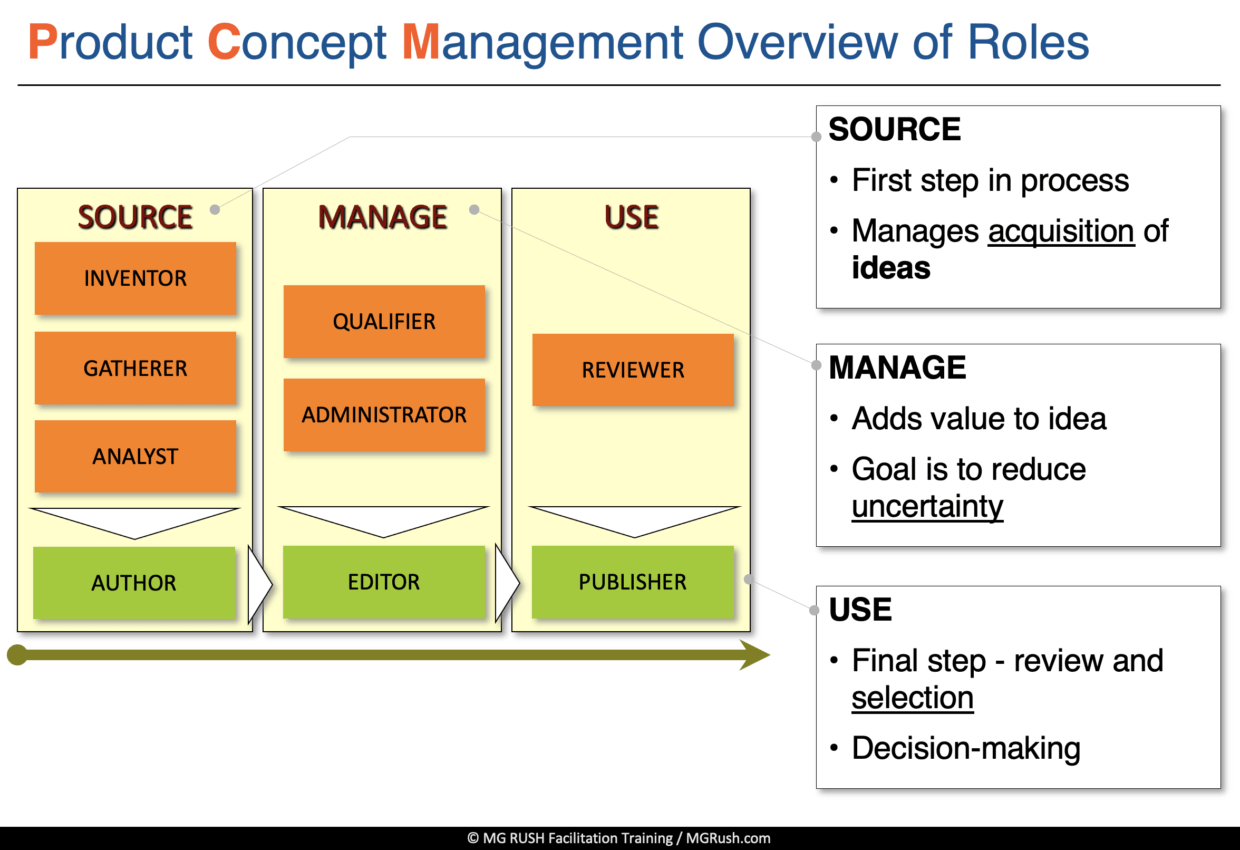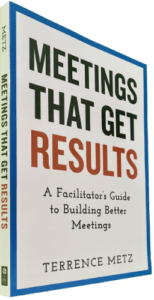Product Concept Management (PCM or Catalyst) is the technique of designing, implementing, and continuously managing the ideation, gathering, qualifying, maintenance, archiving, and evaluation of new product ideas into fully polished concepts.
This article advances a 3-step method you can use to transform new product ideas into innovative sources of revenue and increased efficiencies. If you have suggestions about how we can improve this or other Best Practices, please reply or contact us at (630) 954-5880, or by email at info@mgrushfacilitation.com.
Converting new product ideas into full product concepts requires numerous disciplines, including technical, information systems, creative, marketing, and financial management. This cross-functional demand on an organization is often the point of failure for most organizations in their attempts to maintain a fertile pool of new product ideas.
A NEW PRODUCT IDEA TECHNIQUE
The PCM technique comprises three major steps: “SOURCE” ideas, “MANAGE” ideas (into complete concepts), and “USE” concepts for further evaluation and possible development. These three steps have numerous activities embedded within them.
The most significant step of PCM is to publish (USE) a concept for further development. Without the movement of a product concept onto commercial development, there is no useful work accomplished. At the same time, most businesses focus today on the SOURCING step. That is the SOURCE and volume and “creativity” of the ideas put into the system for consideration.
With our PCM technique, the bulk of activity occurs during the MANAGE step. PCM holds that ideas are raw, slight notions of a product or business opportunity. Most new product people face having enough “good” ideas. In truth, many ideas are “good,” but suffer from a lack of certainty about their future opportunity. In our view, this is what distinguishes good ideas – their degree of certainty. We define the MANAGE step in PCM as the set of activities that convert new product ideas into polished product concepts. The concepts are then available for serious consideration and additional investment.
Polished Product Concept Technique (PCM or Catalyst)
Step |
Description |
Leads To… |
1. SOURCE |
The SOURCE step captures the “authoring” activities where ideas arise—invented, gathered from others, or derived from analysis. Ideation occurs here, from employees, vendors, customers, and field people. Ideas may originate spontaneously, through analysis, or by listening well.
Authors must introduce their ideas in the best form they are able to provide. Groups and teams serve as combined authors. The requirements are low for what is considered an idea, although expectations are high for the effort invested by authors when describing their idea(s). |
MANAGE step |
2. MANAGE |
The MANAGE step converts ideas into tangible concepts, making them available to others over an extended period.
The principle behind qualifying ideas is that all ideas are ‘good,’ but that in their description they carry varying degrees of certainty. The impact of the degree of certainty is that the most ill-formed idea, which is expected to have high potential – with a high degree of certainty – would easily attract investment for further development. Similarly, an elegant idea known to have poor revenue prospects – with certainty – would attract little investment. PCM adds value by reducing uncertainty that matches well with decisions and investments. PCM views that all ideas have value – for someone at some time. Ideas and concepts can have long shelf lives, and some are known to be recognized years after they were first written down. The MANAGE step receives catalogs, stores, updates, files, and fashions ideas into concepts. |
“Use” step |
3. USE |
The USE step provides the first decision on the future use of an idea. The SOURCE and MANAGE steps treat all ideas with a consistent level of interest. The USE step selects ideas from the database and pushes them further, such as a business case. The selection process operates like a query. The reviewer decides on the traits of the idea that will fit the strategic, tactical, portfolio, financial, technical, and social needs. Ideas that satisfy the selection criteria may then be advanced further. | Business evaluation |
WHERE PCM FITS IN NPD
A Typical Gated Process
The gated new product development process consists of activities that evaluate, screen, and develop new products. With a gated process, investments in new products match their potential. New product ideas are refined for their commercial success. Products that appear not to be winners are screened or deleted for further development at one of the gates. The earlier a poor-performing product is screened, the more efficient the process.
The “Stage-Gate™” process from Dr. Cooper of Ontario, Canada[1] has five gates as shown below, and starts with the premise of “a great idea.”
The activities of getting new product ideas, gathering them, and turning them into valid opportunities are often missed. Like the Stage-Gate process, most start with the presumption of “the great idea.” They focus on developing the product, not filling the hopper with complete and robust “ideas.”
PCM revolutionizes the new product development (NPD) process by providing a disciplined method to manage a pool of problems and solutions. PCM fits in front of every NPD process because they all begin with the presumption of a great idea.
The Fit of PCM in Gated Processes
PCM contains a lot of activities (activities to design, use, ideate, gather, qualify, maintain, store, and assess new product ideas) to support the overall goal of building a well-managed source of qualified new product concepts for managers.
We defined three major steps to PCM: SOURCE, MANAGE, and USE. (Using the metaphor from publishing, we also refer to the three steps as Authoring, Editing, and Publishing. The distinct roles for participants in PCM are therefore: Author, Editor, and Publisher.)
PCM is built with Six Sigma methods in mind. In keeping with the spirit of Six Sigma, we will discuss each of the PCM steps using the “right to left” method. Most processes flow from left to right (from inputs to outputs) in a process flow diagram. We will explain from the output back (left) towards the required inputs. This article then focuses on the USE step. Our next and final article (3 of 3) provides more detail on the MANAGE and SOURCE steps.
USE (Publishing — developed product concept)
The USE step reviews ideas for their desirability. When an idea is found to be attractive, it is moved into the next step of a group’s new product process. The USE stage selects ideas that demand more investment. Poor judgment in this stage corrupts the new product process, wastes time and money, and weakens market position.
The USE step is not necessarily a continuous process. It is a discrete activity that occurs when a reviewer has a need or desire to add a new product to his/her new product development portfolio. Thus, the interaction between the MANAGE step and the USE step is intermittent, and largely driven by the event of a “query,” or an attempt by a reviewer to identify another idea worthy of new product development.
USE Step Activities
Descriptions of USE Step Activities
Activities |
Description |
Query |
Submit a query to identify ideas that are of interest or value. |
Review |
Examine ideas returned by the query. Prioritize ideas for their fit and attractiveness. |
Select |
Apply explicit (and implicit) criteria and identify ideas worthy of further development. |
Modify |
Some ideas may be enhanced or made acceptable by changes imposed by the reviewer. Ideas that can be improved in their accuracy (of forecast or technical feasibility), or improved in their acceptability, are modified by the reviewer. |
Feedback |
As conditions change, information is provided to the qualifier to guide future qualifications. As ideas are reviewed, information about the quality of the evaluations is provided to the qualifier. |
Direct |
Direct the qualifier about required and desired analysis, information, and output formats. |
MANAGE (Editing)
The core activity in the MANAGE step improves new product idea quality while storing them. When a new product idea comes from an author, it is added to the idea database. The idea is also qualified so that it can be reviewed by an editor.
MANAGE Step Activities
QUALIFYING
The primary activity in the MANAGE step is “QUALIFYING” an idea. The qualification process is comprised of four activities: Interpretation, Investigation, Analysis, and Forecasting.
Description of MANAGE Step Activities
Activities |
Description |
Log |
Review recent ideas. Assess for completeness and prioritize for qualification. (If there are more than one qualifier or multi-person (team) qualifiers, assign the team.) |
Qualify |
|
|
Judge the idea for clarity. As needed, speak with the author to further describe, clarify, and refine the idea.
Interpret an idea for its commercial and technical content (may contain industry, segment, and other specific vocabulary and meaning). Review the idea for completeness, and get the idea author to provide more information. Detect the timeframe for use of the idea (near-term, distant, event-triggered, etc.). |
|
Assess the information to adequately qualify for the opportunity. Identify sources of information and required methods.
Perform an investigation of the ideal opportunity. Gather information about marketing, distribution, technical development, production, customer demand, competition, and regulation. |
|
Analyze the opportunity for (1) technical feasibility; (2) customer appeal and purchase behavior; (3) fit with distribution channels; (4) competitive options and positioning, (5) trends and future market conditions; and (6) fit with existing product portfolio, cannabilistic impact, and marketing strategies.
Determine market(s) size or impact on customer lifetime value. Build assumptions. |
|
Forecast revenue stream, investment, and timing. |
Store |
Finish documentation; update idea database. |
Archive |
Assess the inventory of ideas for relevance. |
Feedback |
Feed back to idea authors about the status of their submittals. (Not intended to provide direction to authors about the likelihood of an idea being used for more development.) |
Coach |
Give support to authors to encourage submissions and enhance the completion of their ideas, including support around customer motivation, competitive choices, and tangential uses. |
SOURCE (Authoring — capturing new product ideas)
The core activity in the SOURCE step is discovering ideas, and describing them sufficiently to be added to the PCM organization. When a new product idea is conceived, it is first put to paper to describe – as well as the author can – the need for, performance, and benefits of the new product idea.
SOURCE Step Activities
Articulated ideas are added to the company’s idea database. The SOURCE step is ongoing as well as ad hoc, built of (possibly) many sources of ideas. There are three primary types of DISCOVERING activities: Invent, Gather, and Analyze.
DISCOVERING
SOURCING is the most complex, far-flung, and resource-intensive activity of the three major steps within PCM. When launched on a wide scale, SOURCING spans time (present and future opportunities), spans the organization (engineering, marketing, service, and manufacturing, e.g.), and spans the marketplace (suppliers, distributors, customers, potential customers, e.g.). Thus, SOURCING places great demands on the PCM group to properly direct, manage, and resource activities to gather new product ideas.
Description of SOURCING Step Activities
Activities |
Description |
Discover |
|
√ Invent |
Conceive ideas about problems and potential solutions. |
√ Gather |
Observe and collect the points of view of others. |
√ Analyze |
Compare ideas to product line gaps, competitors’ offerings, and future trends. |
Articulate |
Express an idea in a form that gives adequate information to qualify further. |
Submit |
Input of an idea for qualification (usually into an idea “hopper” or database). |
Motivate |
Provide reasons to authors to build and submit ideas. Can be the design and use of incentives and performance rewards. |
Train |
Prepare authors to invent, analyze, or gather ideas or idea fragments by providing instruction in various methods of problem/opportunity recognition and idea formation. |
Equip |
Furnish authors with direction in the areas where ideas are desired, and by giving them tools, templates, and equipment to identify problems/opportunities, and clarify ideas. |
Our summary spares you, the reader, from many of the details found in the transformation of new product ideas. For more information, simply drop us a note at info@mgrushfaciltation.com. Our final article (3 of 3) in this series will focus on details that support the MANAGING and SOURCING steps.
~~~~~~~~~~~~~~~~~~~~~~~~~~~~~~~~~~~~~~~~~
[1] Business Horizons, Volume 33, Issue 3, May–June 1990, Pages 44-54, Stage-gate systems: A new tool for managing new products, Robert G.Cooper
______
Don’t ruin your career by hosting bad meetings. Sign up for a workshop or send this to someone who should. MGRUSH workshops focus on meeting design and practice. Each person practices tools, methods, and activities daily during the week. We call it the road to building high-value facilitation skills.
Our workshops also provide a superb way to earn up to 40 SEUs from the Scrum Alliance, 40 CDUs from IIBA, 40 Continuous Learning Points (CLPs) based on Federal Acquisition Certification Continuous Professional Learning Requirements using Training and Education activities, 40 Professional Development Units (PDUs) from SAVE International, as well as 4.0 CEUs for other professions. (See workshop and Reference Manual descriptions for details.)
Want a free 10-minute break timer? Sign up for our once-monthly newsletter HERE and receive a free timer along with four other of our favorite facilitation tools.
Go to the Training Store to access proven, in-house resources, including detailed agendas, break timers, and templates. Finally, take a few seconds to buy us a cup of coffee and please SHARE with others.
In conclusion, we dare you to embrace the will, wisdom, and activities that amplify a facilitative leader. #facilitationtraining #MEETING DESIGN
______
With Bookmarks no longer a feature in WordPress, we need to append the following for your benefit and reference
- 20 Prioritization Techniques = https://foldingburritos.com/product-prioritization-techniques/
- Creativity Techniques = https://www.mycoted.com/Category:Creativity_Techniques
- Facilitation Training Calendar = https://mgrush.com/public-facilitation-training-calendar/
- Liberating Structures = http://www.liberatingstructures.com/ls-menu
- Management Methods = https://www.valuebasedmanagement.net
- Newseum = https://www.freedomforum.org/todaysfrontpages/
- People Search = https://pudding.cool/2019/05/people-map/
- Project Gutenberg = http://www.gutenberg.org/wiki/Main_Page
- Scrum Events Agendas = https://mgrush.com/blog/scrum-facilitation/
- Speed test = https://www.speedtest.net/result/8715401342
- Teleconference call = https://youtu.be/DYu_bGbZiiQ
- The Size of Space = https://neal.fun/size-of-space/
- Thiagi/ 400 ready-to-use training games = http://thiagi.net/archive/www/games.html
- Visualization methods = http://www.visual-literacy.org/periodic_table/periodic_table.html#
- Walking Gorilla = https://youtu.be/vJG698U2Mvo

Terrence Metz, president of MG RUSH Facilitation Training, was just 22-years-old and working as a Sales Engineer at Honeywell when he recognized a widespread problem—most meetings were ineffective and poorly led, wasting both time and company resources. However, he also observed meetings that worked. What set them apart? A well-prepared leader who structured the session to ensure participants contributed meaningfully and achieved clear outcomes.
Throughout his career, Metz, who earned an MBA from Kellogg (Northwestern University) experienced and also trained in various facilitation techniques. In 2004, he purchased MG RUSH where he shifted his focus toward improving established meeting designs and building a curriculum that would teach others how to lead, facilitate, and structure meetings that drive results. His expertise in training world-class facilitators led to the 2020 publication of Meetings That Get Results: A Guide to Building Better Meetings, a comprehensive resource on effectively building consensus.
Grounded in the principle that “nobody is smarter than everybody,” the book details the why, what, and how of building consensus when making decisions, planning, and solving problems. Along with a Participant’s Guide and supplemental workshops, it supports learning from foundational awareness to professional certification.
Metz’s first book, Change or Die: A Business Process Improvement Manual, tackled the challenges of process optimization. His upcoming book, Catalyst: Facilitating Innovation, focuses on meetings and workshops that don’t simply end when time runs out but conclude with actionable next steps and clear assignments—ensuring progress beyond discussions and ideas.






